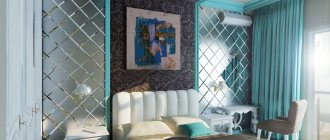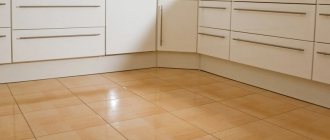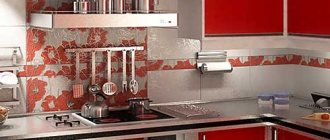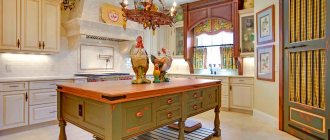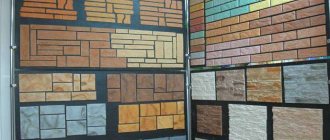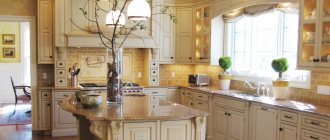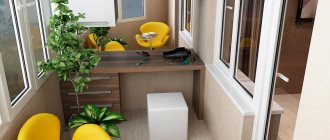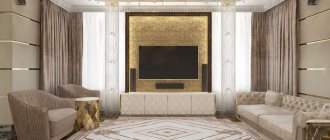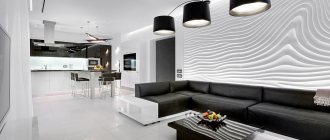Features and advantages of mirror tiles in the interior
Tiles with a mirror surface are an original finishing solution. This material is able to visually increase the area of a room, mask repair flaws and stylishly decorate walls in standard apartments or private houses.
The tiled surface has almost one hundred percent reflective ability. It is resistant to mechanical stress, shock, high temperatures, moisture or chemical reagents.
Mirror tiles look beautiful and interesting. Thanks to the variety of colors and configuration types, you can create a variety of images from this decorative material. These decorative parts are easy to install. Even a non-professional can handle its installation. But over time, black spots appear on this material, as well as stains if the surface is washed not with special cleaning agents, but with water.
What is special about mirror tiles as a decorative material?
The key difference of the product lies in its decorative functions. The material has many advantages that allow you to solve several problems at once. It is perfect for rooms with surface defects, a small area and a limited amount of natural light.
A mirror composition can become a decisive detail of the interior
Some doubt the strength of the product, believing that fragility affects wear resistance. Modern capabilities make it possible to make the element high-quality and reliable.
Types and types of tiles
There are many types of tiles that are used in different interiors. Depending on its type, the installation of this decorative material differs. Smooth tiles without relief are laid in such a way that their joints are invisible. This allows you to make real mirror canvases from it, which look impressive in minimalism and hi-tech styles.
Beveled tiles help create complex surfaces for palace and classical interiors.
Bevel - beveled edge of mirror glass
Tiles with an imitation metal surface (bronze, silver, gold) are suitable for all styles. Material with a regular or textured pattern (texture) gives the interior individuality and expressiveness. Tinted mirror tiles are distinguished by different shades of glass or amalgam surface: smoky gray, white, pink. Mirror mosaic will fit into Art Deco and Art Nouveau styles.
Mirror tiles are also classified according to their shape; the most common options are: square, triangular, rectangular, hexagonal (honeycomb).
Sizes and shapes of mirror tiles
Tiles come in different sizes and shapes. There are no specific standards for its manufacture. Most often in repair and finishing work, tiles of the sizes indicated in the table below are found.
Let the designer choose the size of the mirror tiles.
| Tile shape | Size (length and width) |
| Square | 50x50, 100x100, 150x150, 200x200, 250x250, 300x300, 400x400, 500x500, 600x600 |
| Triangular (equilateral) | 150x150, 200x200, 300x300, 400x400 |
| Rectangular | 50x100, 50x150, 50x200, 100x150, 100x200, 100x600, 100x1000, 100x1200, 150x200, 150x600, 150x1200, 200x300, 250x400, 300x40 0, 300x600 |
| Arched | 150x150, 200x200, 300x300, 400x400 |
Note! The thickness of the material varies from 2 to 4 mm. It is very important to pay attention to the width of the bevel; it can be 10, 20, 30, 50 mm.
Hexagons look unusual in the interior.
A tile in the shape of a honeycomb (hexagon) is gaining popularity. Honeycombs in combination with aged structures are used to create a special vintage, eclectic and baroque interior. For a more modern design (for example, loft style, minimalism, hi-tech), the tiles can be placed at different distances from the wall, thereby creating a panel with a 3D effect.
When properly installed and used, mirror tiles are very durable.
Production and technical specifications
Due to their structural features, mirror tiles are produced differently from ordinary ceramic tiles. In production, large canvases are first taken, which are automatically cut into individual segments of the desired shape and size.
The mirror surface itself is made using the damping method. Special crystalline substances are added to the molten glass, which subsequently give the tile surface a characteristic shine.
After cutting, the material is ground and polished, carefully processing the edges. But sometimes this decorative element is made of polystyrene. In this case, it can be easily cut, painted, or even embossed designs can be created on its surface. But this material is not environmentally friendly, and designs on the reflective surface are made using sandblasting.
The distinctive technical properties of mirror tiles include moisture resistance and environmental friendliness.
Caring for mirror surfaces in the interior
In order for the tile to retain its attractive appearance longer, it is necessary to provide it with proper care. It is easy to wash and does not get very dirty. This is due to the advantages:
- Does not wear off due to friction.
- Maintains shine for a long time.
- Does not fade under sunlight.
- No fading.
Miniature mirrors do not require special care
There are products with a special coating that allows them not to fade for a long time.
Interior decoration
Mirror tiles can be used in almost any interior. It is convenient to apply to a wide variety of materials: plastic, metal, ceramics, etc. But when using this decorative element you need to know a sense of proportion. A large number of mirrors and stained glass windows in a room negatively affect a person’s psychological state.
You can use mirror tiles only on two adjacent surfaces, for example, on the ceiling and one of the walls, but in this case it is better to take materials with different textures or patterns. It is not worth covering the ceiling completely with mirrors, because... It may feel like the room is upside down. It is more expedient to decorate only part of the ceiling with this material.
To ensure that the light reflected on the surface of the mirrors does not tire the eyes of the beholder, it is better to use lamps with a soft matte glow or LEDs.
You can use mirror tiles in any room of an apartment or private house.
4.1 Hallway interior
Reflective surfaces allow you to visually enlarge a small hallway and harmoniously decorate a large hall. If the apartment has a narrow, long corridor, then there is no need to decorate both walls with mirrors at once; you should limit yourself to only one plane.
In small hallways, you can line part of the wall with this material and hang lampshades above them. This will make the corridor visually more spacious and comfortable.
In the halls, mosaic tiles look great, effectively decorating one of the walls. Mirrors also look good in a hallway niche. A wardrobe is usually placed in it, but if there is no need to install it, this niche can be decorated with mirror tiles with ornaments or bright designs.
The tiles often depict:
- hieroglyphs;
- silhouettes of people, animals and birds;
- flowers;
- eastern ligature.
4.2 Living room design
Mirror tiles in the living room are often used to zone the room. Often it is used to highlight a fireplace or a sofa. In private homes, columns and niches are decorated with this material. The fireplace framed by a mirror mosaic looks very impressive. You can also make a stripe on the wall from this tile, placing flowers or floor lamps next to it. Thanks to this technique, it will seem that there is a lot of color and light in the living room.
This material is also used to decorate furniture. They can be used to lay out wall shelves or shelving facades. Moreover, mirror tiles will be appropriate in palace, urban, and oriental interiors.
A mosaic of mirrors is suitable for a kitsch-style interior, creating unusual multi-colored tints. You can decorate one of the living room walls with classic tiles, and then place a stylish sofa next to it. Its straight lines will look good against a mirror background.
4.3 Kitchen decoration
Mirror tiles in a post-Soviet kitchen look unexpected, although acceptable. This decorative item is not only beautiful, but also functional. It is ideal for classic small kitchens in typical homes. Mirror tiles can be used to decorate the kitchen apron. This tile can be decorated with interesting designs, ornaments or holography.
For kitchen sets in a classic style, aged mirror tiles are suitable. On such a surface, stains, drops of water and fat are almost invisible. This decorative material can be used to decorate the wall above the kitchen unit if there are no top drawers, or the wall next to which the dining group is located. This technique will help give a narrow and long kitchen a square shape. And, of course, you can decorate the facade of the kitchen unit with mirror tiles.
4.4 Bedroom design options
Mirror tiles in the bedroom make the room unusual and piquant. From this material you can make a completely monolithic wall or a mirror ceiling. But such an installation should not be placed directly opposite the window; the tiles will look much more impressive to the left or right of it.
If a wall decorated with mirror tiles reflects sources of artificial light, this can make the room brighter and more comfortable. But this finishing method is only suitable for large rooms. In small bedrooms, it would be more appropriate to decorate only part of the wall with mirror tiles, for example, the head of the bed.
The doors of wardrobes, bedside tables or chests of drawers for linen are often decorated with tiles, and beds are also decorated with mirror tiles, but this will not be appropriate in all interior styles.
4.5 In the children's room
The presence of a mirror wall in a children's room causes controversy among designers and psychologists. Of course, such tiles will look impressive and stylish, turning the nursery into a fairy-tale corner, but from a psychological point of view, this piece of furniture is inappropriate in rooms for small children.
A wall made of mirror mosaic can disrupt a child’s sense of reality, so this interior element is suitable only in rooms for teenagers. In other cases, you can hang a panel of mirror tiles on the wall or decorate the clock in the room with tiles. But such decor is not recommended to be placed in front of the child’s eyes: above the desk, opposite the bed or in the sports area next to the wall bars. Mirror tiles are best placed in places where sunlight and light from lamps, floor lamps or ceiling chandeliers fall.
4.6 Bathroom
Mirror tiles are appropriate in any bathroom. One of the walls of the bathroom can be made completely mirrored: from regular or mosaic tiles.
This finishing method looks beautiful and is one of the most practical. A wall of mirrors opposite a window or bathtub looks especially impressive. This makes the bathroom light, bright and airy.
Mirror tiles do not deteriorate from moisture and are practically resistant to its effects. You can use it to lay out the ceiling or part of it, giving the interior a romantic style. When decorating a bathroom, some people combine ceramic and mirror tiles, and spectacular shiny inserts appear in ordinary white tiled walls.
This material can be used to decorate the facade of bathroom furniture. But there is no need to make the bathroom completely mirrored, decorating the ceiling, walls, and furniture with these tiles. This can make the bathroom cold and uncomfortable, even if warm colors are used in the interior.
Shapes of beveled mirror in the interior
A traditional wall mirror is not the only form of facet decor in the interior. There are other, more original ways to use it.
Panel
Beveled mirror panels are very common in home interiors. As a rule, such a composition is assembled from diamond-shaped elements, since edges beveled at an angle reflect light from windows or lamps more effectively than others.
Photo: dobrahata.com.u
The most common decoration option is to hang several panels on the walls of the room, especially if they are not too large.
Mirror wall
Another decoration option is to decorate the apartment not in individual areas, but in an entire mirrored wall with a beveled effect. It will serve as an accent, the brightest and most original wall in the interior. It will also replace the traditional mirror.
Photo: booxmaker.fr
It is important to place such a wall opposite a window or light-colored pieces of furniture to ensure the most effective reflection of light.
Faceted mirror on furniture
The most unusual and modern design option is to add furniture with a mirrored beveled surface to the room. It will become a very bright and original decor and will help add originality to the interior.
Calculate the exact cost of repairs using an online calculator
and receive a free detailed estimate for repairs
Calculate
Photo: aviarydecor.com
The most common use of bevel on furniture is a cabinet with mirrored doors. However, there are more original design solutions: for example, a completely beveled coffee table.
Features of self-installation
Mirror tiles are easy to install yourself, which is probably why they are so popular today. Its installation is practically no different from laying simple tiles. But you need to take special adhesives, since ordinary cement-based adhesive spoils the reflective layer of the tile - the mirror amalgam.
Laying begins with preparing the walls: the remnants of the wallpaper are torn off, the walls are plastered, all protrusions are removed, and then the surface is treated with a primer. In bathrooms and bathrooms, the walls are also treated with special substances against mold and mildew.
After the primer has dried, you need to draw markings directly on the wall and begin work on laying the decorative material. In bathrooms and kitchens, a small (1-2 mm) thermal joint should be left between the tiles. Traditionally, this material is attached from the bottom up, after which all seams are rubbed down and the lining is cleaned of traces of glue.
Useful video on installing mirror tile panels:
Recommendations for DIY installation
Many people are accustomed to doing all home repairs with their own hands. Some people save money this way, while others simply don’t trust unfamiliar craftsmen. Whatever the reasons, if you decide to install mirror tiles yourself, there are key points you need to know. The surface must be prepared as before laying regular tiles. But the installation process itself has some features:
- Before laying, lay all the tiles on the floor in the required sequence. Assess the width of the gaps and the need for trimming;
- Pre-size all elements;
- If the surface of the tile is opaque, but at the same time smooth, then it is necessary to create a slight roughness on it. To do this, it is sprinkled with coarse sand. This is done to ensure better adhesion to the base material;
- If the tile is transparent, liquid glue is applied to the back side and coarse sand is added;
- Liquid nails or neutral silicone without acids are used as an adhesive mixture
- The edges of mirror tiles will have certain deviations from uniformity, so make seams at least 2 mm thick;
- The first row must be horizontal;
- Press the tiles down using a piece of cloth. This will help avoid contamination;
- The finishing film should be removed only after all work has been completed;
- The finished masonry should be left for several days until completely dry;
- Only after this, start grouting the joints with special silicone;
- After it has dried, clean the surface of the tiles with a dry cloth. The best material for this is microfiber.
After successful completion of installation work, you can enjoy a unique design made by yourself.
Tags:Apartment design
Care Tips
Tiles with a mirror surface are easy to use and care for on a daily basis. It should be wiped regularly with a damp cloth. To avoid streaks, you need to use not just tap water, but special mirror cleaners or table vinegar.
After treating with these compounds, you need to wait a little, and then rinse them off with ordinary running water, and then wipe the surface with a dry rag or cellulose napkin.
Do not rub the mirror surface with hard sponges, as this can cause the tile to become deformed and become scratched.
In bathrooms, mirror tiles and the joints between them can sometimes be treated with special antifungal compounds. Otherwise, caring for this material is no different from caring for ceramic tiles or mirrors.
If dust and dirt appear on the mirror tiles, they can be easily washed with a regular glass cleaner. The matte surface should be cleaned with plain water and vinegar. For severe stains, cleaning agents for removing limestone are suitable.
Positive and negative aspects of use
The materials used to produce products with a reflective surface are chemically stable and neutral. They are not subject to deterioration from contact with water or cleaning agents, so they can also be used for covering surfaces in rooms with high humidity.
The unusual appearance can be easily emphasized by the installation method, placing square elements diagonally or using tiles of a different shape. This technique allows you to create a kaleidoscope effect, making the reflection broken into parts. The use of mirrors is appropriate in combination with various stylistic trends: it harmoniously combines with classics and is also suitable for creating a modern interior.
The disadvantage of the abundance of mirrors can be considered the coldness of the interior, which is created with their help. A shiny reflective surface can also negatively affect people with mental disorders. It is not recommended to mirror 2 opposite walls: the room will look like a tunnel. On connecting surfaces (for example, a wall and a ceiling), it is better to use mirrors with different surfaces (smooth and patterned, colored, dark, etc.). This will avoid the effect of broken space.
Due to their reflective properties, any mirrored surface can create glare. When using bright lamps in lighting fixtures, artificial light can become too intrusive and irritate the eyes. A matte lamp will help avoid this.
Installing tiles on the ceiling in a low room helps to visually lift it and make the room brighter. The advantage of using it will also be appreciated by those who decide to make a small insert: it will create the effect of a room with a second light. The same technique is used for zoning combined rooms.
How to use it correctly?
It is very important to place a beveled mirror in the room correctly, otherwise, instead of an elegant design, you can get the opposite effect. To do this, you should follow the designers' recommendations:
- To fill a dark room with additional light, a decorative element must be placed opposite the window.
- You should not place the mirror in front of dark things. When reflected, they will make the room even darker.
- It is not recommended to use a reflective wall opposite the bed. According to psychology, such an arrangement can disrupt restful sleep.
- It is worth taking care of safety and not placing a beveled mirror in an inappropriate place. For example, such a mirror should not be placed in a child’s room if the child is still of an unconscious age.
By correctly placing beveled mirror products, you can undoubtedly create a luxurious interior with a pleasant atmosphere. This solution will help to realize unusual design ideas and embody illusions in the interior.
How to decorate the interior with mirror tiles?
Mirror tiles are used in all types of interiors: in the living room, dining room, hallway, kitchen, bathroom or dressing room. As a rule, they decorate one wall or a small fragment of it. Here are some ideas on how to introduce mirrored tiles into your home decor.
In the kitchen and bathroom, tiles should be considered as an alternative to the popular ceramic tiles. A shiny glass panel can decorate the wall between the kitchen counter and cabinets, the corner of a sink, or the wall behind a freestanding bathtub.
Which mirror tile to choose? Review of materials
The choice of material is the key criterion to follow when purchasing mirror tiles. Essentially, you have two options: acrylic mirror tiles and glass mirror tiles .
Acrylic mirror tiles are made from a lightweight, unbreakable plastic called plexiglass or safety mirror . Unlike glass tiles, they guarantee complete safety. Even if the decoration falls from the wall onto a hard floor, it will remain intact.
Perspex also has the advantage of being easy to work with, and tiles made from it can take any shape. Laying tiles is fast and efficient. Plastic tiles are very lightweight, so simply stick them to the wall with double-sided tape.
At the same time, plexiglass is a soft material that is easily scratched and erased. Even cleaning the surface too vigorously can cause damage, including minor scratches and abrasions. Acrylic mirror tiles, especially in large sizes, distort reflections, so they are not a substitute for traditional glass mirrors.
All this makes them suitable only for decorative purposes and therefore for decorating small areas, such as the wall above the sofa in the living room or a door.
Mirror glass tiles have completely different parameters than plexiglass products. Although they can break or crack if subjected to a strong impact (such as from a heavy object), they do not cause any problems in everyday use.
Glass, as a material with high hardness, does not scratch or fade. Its smooth, non-porous surface makes it easy to remove any dirt while providing a clear and accurate reflection. Mirror tiles made from glass are renowned for their elegant appearance.
Of course, the quality of the product is of great importance. Cheap tiles made from glass waste or imported from Asia may have minor manufacturing defects (black spots and discoloration). In addition, they are susceptible to corrosion and are quite problematic to maintain. That's why it's so important to choose tiles from trusted manufacturers who specialize in glass products and use high-quality materials.
Are mirror tiles suitable in the kitchen, bathroom or hallway?
Many people think that mirror tiles are too fragile and delicate to be used in the bathroom or exposed to dirt in the hallway. However, manufacturers guarantee that there are no contraindications for this. The glass surface of the tile is perfectly smooth, without pores, depressions or irregularities in which dirt can settle.
Thanks to this, it makes it easy to remove any stain and keep the wall perfectly clean. At the same time, the tiles are resistant to moisture, high temperatures and chemicals.
Of course, not every product can cope with difficult conditions. In the kitchen, bathroom or hallway, use high-quality glass mirror tiles. The tiles must have a reinforced backing and properly protected edges to prevent corrosion.
From the history
The first known mirrors were dated by scientists back to the Bronze Age. For a long time, a mirror was a very expensive thing - only very wealthy people could afford to have this item. The price of one item reflecting the image could reach the cost of an entire estate. Mirrors have been used as a decorative element of the interior, and not just as a utilitarian object, since the time when manufacturing technology made it possible to at least slightly simplify and reduce the cost of the process. One of the first interiors in which mirrors were used in decoration was the Mirror Cabinet of the French Queen Marie de' Medici.
Minimalistic kitchen interior with mirror tiles
Today, mirrors are no longer a luxury item available only to royalty. The secret of their manufacture has long ceased to be a secret, for which some masters dedicated to it paid with their lives. Therefore, now we can easily afford to use mirror tiles of any shape and size in finishing, with or without bevel.
What is facet
From French, the word “facet” is translated as “edge” or “plane of a faceted thing.” This is a special decorative processing technique that is used in jewelry to give semi-precious and precious stones a finished look. Almost immediately, glass and mirror manufacturers adopted the bevel technique. Products processed in this way looked very impressive and impressed with the shimmer of color and light.
Mirror tiles with bevel
Facet on glass
Facets for stained glass
The bevel technique affects not only the aesthetic properties of products, but also greatly simplifies their installation. For example, beveled mirror tiles are much easier to insert into a wooden or metal frame due to the beveled edges of the elements. This makes the assembly of decorative items and furniture with such inserts safer and less time consuming.
Bevel making process
Previously, the technique of bevelling glass and mirror surfaces was time-consuming. The craftsmen worked millimeter by millimeter, carefully removing the edge of the material. Sometimes it was necessary to modify the product manually. Hand trembling or excessive pressure could ruin the material.
Nowadays, bevels on glass or mirrors are made using a special bevel machine. It allows you to create an edge of any width and with different angles of inclination - from 5 to 40 mm and from 1 to 45°, respectively. Before work, the material is cut into fragments of the required sizes, after which the master grinds off the edge, grinds and polishes it.
Preparing glass for making bevels: photo of the work
The speed of making a bevel on a mirror or glass depends on the complexity of the work itself and the experience of the craftsman. The price of the finished product processed using this technique will naturally be higher. But even with a quick glance at the decorative items and furniture, it becomes clear that the cost is quite justified.
Look how impressive the diamond-beveled mirror panel and wardrobe doors look:
Mirror tiles with bevel in the hallway
Sliding wardrobe: mirror with bevel
Facets on glass and mirrors come in different types. It all depends on how the master processes the edge of the material:
- Straight facet. Products processed in this way can be easily distinguished by the presence of a straight cut. The width of the bevel itself (bevel to the edge) can reach 40 mm - it all depends on the size of the workpiece. The tilt angle varies from 3 to 45°. Massive products, for example, heavy multi-layer mirrors or beveled mirror panels, must be polished to make the edge look more attractive.
- Curvilinear bevel. This technique is chosen for processing fairly large products (at least 45 cm) of unusual shape. In the process of making a facet, the master adjusts not only the direction of the cutting line, but also the angle of inclination.
- Double facet. Craftsmen choose this processing method when creating multilayer mirrors. To create a double decorative edge, a bevel is made on each fragment, and then the products are joined.
- Double-sided cut. The double-sided cutting technique is more often used for processing stained glass, glass interior doors and windows. In this case, the edge of the product is subjected to decorative processing on both sides.
See what bevels of all types look like on mirrors and stained glass windows:
Straight bevel on the mirror
Facet using double-sided cutting technique
Double bevel on the mirror
Curvilinear bevel on bevels
This is interesting:
Mirror furniture is a unique chance to change the interior
